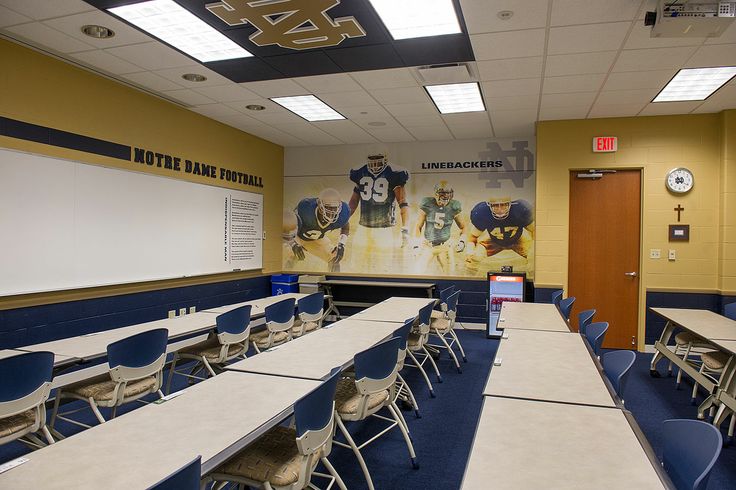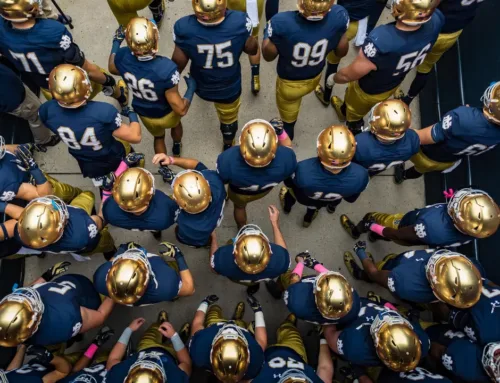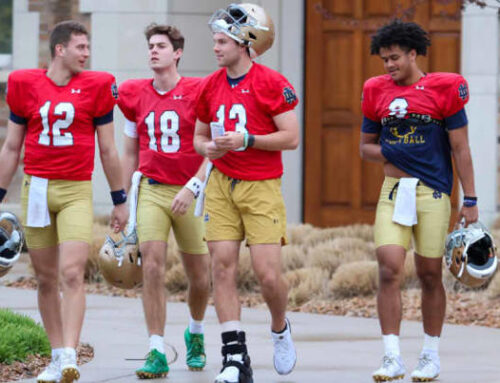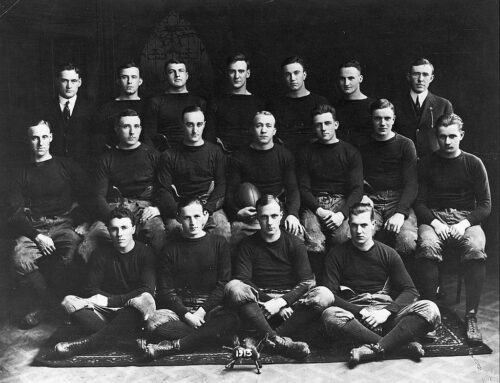Out of the 14 passes that Peacock graced us with a decent angle for, the most common concept by far was Snag (6/14). Snag is a passing concept that is used at pretty much all levels. Snag can be separated into two categories, two man Snag and three man Snag. The origin of this concept comes from the West Coast offensive innovator Bill Walsh.
If you like to eat your dessert first and see some plays and diagrams now here you go.
Notre Dame in the 2023 Blue & Gold Game ran two man and three man Snag exclusively from condensed formations. These formations are known colloquially as “Bunch” if it features on one side three receivers and “Tight” if it features two. Notre Dame also ran a 3 man Snag out of a 2×2 formation by utilizing the running back for the flat route. The backside of Snag typically consists of some sort of quick game concept that is unrelated to Snag: Curl-Flat and Double Slants or Double Ins are common.
Three man Snag
Three man Snag is the traditional triangle stretch of the defense, known as such because there is a vertical threat (Corner) and then two horizontal threats (Snag & Flat) all at different depths. This triangle causes the defense to have to defend a triangle area of the field and it is particularly nasty versus zone coverage. Snag primarily causes conflict against the flat defender. Snag is also effective versus man coverage due to the “rub” that is created.
Empty 3×2 Snag
In this play, Gerad Parker dialed up an empty formation with the left side receivers in a bunch grouping. In an empty formation, there is no additional protection for the Quarterback (#10 Sam Hartman). Because of this, a quick passing concept like Snag is especially helpful to keep the offense in rhythm. On the left side of the formation, the outside Wide Receiver (#83 WR Jayden Thomas) is running the snag route. The middle Tight end (#38 TE Davis Sherwood) is running the corner and the inside receiver (#19 WR Jaden Greathouse – it was hard to see the number, I could be wrong) is running the arrow/flat. The defense keys in on the corner route by Davis and the arrow route by Jaden which leaves Jayden open with room to spare. Sam makes the quick and correct decision and throws the Snag route. Mr. Thomas breaks, or was the recipient of a bad tackle, and makes a nifty move to the end zone for a Gold team touchdown.
2×2 Snag
In the next play, Sam Hartman is leading the Gold team with a 2×2 formation. Both receivers on the offense’s right are off the screen, but one will come on-screen later. To the offensive left is the Snag concept. This is a creative use of personnel as both “receivers” on the left side of the line are Tight Ends. The outside Tight End, (#23 TE Justin Fisher), has the snag route while the slot Tight End, (#38 TE Davis Sherwood), has the corner. Running Back #33 Sam Assaf has the flat route. The flat defender is put in just enough conflict that the Snag route comes open allowing for Sam Hartman to move the chains for a Gold team first down.
Two man Snag
Two man Snag, as Notre Dame ran it, is more of a “rub” play with a snag route coming in from the outside and arrow/flat routes coming from the inside slot. Notre Dame ran this play from a “2×2” tight formation. Gerad again utilized 12 personnel (2 Tight Ends, 1 Running Back) with the Tight Ends split out into the slot. On the bottom side, at the outside, Braylon (WR #14 Braylon James ) runs a Snag route while a hard-to-identify (Perhaps?) Tight End runs the arrow route.
At the top side, on the outside Rico (WR #17 Rico Flores Jr. ) runs a longer Snag/curl route while on the inside Tight End Hakim (TE #35 Hakim Sanfo) runs an arrow with a bit more depth than the other side. For all intents an purposes this is a mirrored concept where QB Kenny Minchev (QB #8 Kenny Minchey) can choose which side of the field is more favorable. Both routes create a “rub” so they are favorable versus man coverage, however not all plans survive contact with the enemy. The Gold team is running a 2 shell zone defense with 5 underneath defenders. Those 5 defenders are guarding 4 receiving threats, and frankly that spells certain trouble for Kenny. Kenny makes the best outcome possible and scampers for a short gain.
Conclusion
Snag is a quick hitting, rub and/or triangle read that puts man and zone defenders in quite the pickle. If the defender chooses to overplay the closer routes, the deep throw opens up for a devastating gain. One play I hope to see Notre Dame utilize in this season, as a compliment to Snag, is Stick. Stick basically consists of the same threatening triangle as Snag, but reverses two of the responsibilities to other receivers. Stick doesn’t take much practice time once Snag is installed. Both Snag and Stick can be used in either a Run Pass Option (RPO) or Pass Run Option (Stick-Draw).
Further Reading
http://brophyfootball.blogspot.com/2009/09/snag-route-noel-mazzone-ny-jets.html
https://weeklyspiral.com/2021/05/03/snag-concept/
https://wesleyrossfootball.substack.com/p/how-zach-kittley-used-the-snag-concept
https://wesleyrossfootball.substack.com/p/bill-walsh-the-stick-concept-and





Great article thanks for explaining the route concept!
Have you checked out this YouTube channel, the QB School?
https://youtu.be/0CGp6nHiYZg
JT Osullivan, former journeyman NFL QB gives excellent insight into quarterback play, route concepts, and the video link above explains this route concept too.
Keep these coming please!
Thank you.
Qb school is awesome, I didn’t know he put out a video for snag, I’ll have to check it out to see what I missed!
Good to see these film rooms start popping back up. Always an interesting read!
These film room posts are great. I’m glad they’re back, almost as glad as I’ll be to see a functional passing game for the first time in years.